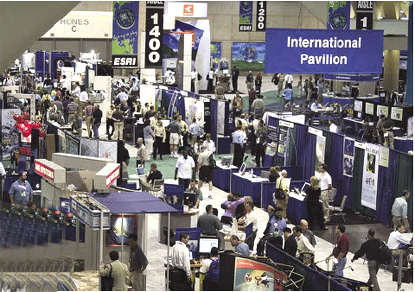| Conference | |
GIS – Helping manage our world JIM BAUMANN, ESRI
|
||||

With nearly 13,000 users attending from more than 135 countries, ESRI’s 25th annual International User Conference again demonstrated the company’s strength in the industry. By the numbers, there were about 1,150 paper sessions and panel discussions, more than 400 technical workshops, 112 special interest group meetings, and 23 special displays. In addition, ESRI staged four concurrent conferences including the Senior Executive Seminar, Telecom, Survey Summit, and EdUC that had a combined attendance of about 1,300, as well as 38 preconference seminars that attracted more than 1,400 attendees. Elaborating on this year’s conference theme, GIS – Helping Manage our World, ESRI president, Jack Dangermond said, “GIS provides a particularly valuable framework for managing both human and natural activities because it facilitates the integration and analysis of complex data, making it readily accessible to scientists, planners, and the general public. GIS is now evolving on the Internet, creating a kind of distributed global GIS. We are using it for publishing our maps and our data, and now with Web Services, we’re beginning to link together applications that are modeled to data remotely accessible across the Web. I think that this will evolve into something I like to call the GeoWeb; a large, widespread, distributed collaboration of knowledge and discovery that promotes and sustains worldwide sharing and interoperability. I see a fabric of applications that work together synergistically for a whole range of purposes.” At a press conference, Dangermond and others discussed the next generation of MapMachine, the online atlas hosted by the National Geographic Society. Plans include a link to the data and metadata of the Geospatial One-Stop (GOS) portal, as well as the addition of 3D globe services, which will allow users to drape their own data onto an interactive globe. The big product announcements at the conference concerned the powerful new features in ArcGIS 9.2, which will be available early next year. Commented Clint Brown, ESRI’s Director of Software Products, “At 9.2, we’ll see the addition of COGO construction tools, better attribute editing, and better raster to vector conversion. In Survey Analyst, we’ll be implementing a complete workfl ow for cadastral data measurements to be integrated inside of a GIS, and also improvements in the CAD area with better annotation support, better native. rendering, and better support for georeferencing. We will also continue to support heavily interoperability in two ways: Continued support for some of the new standards coming forth in OGC, on both the server and on the client, and also the addition of new data sources in the data interoperability extension. This interoperability procedure is very important, particularly when we talk about the GeoWeb. It’s a kind of key for bringing the maps, the schema maps and the semantic maps of distributed organizations together. “At 9.2, we’re also going to be introducing something called a design or sketching tool for geographic information. The idea is that with symbolic representation, I could design a scheme, plan, or a landuse plan, and then have that graphic design represented in geographic features in the geodatabase that I can analyze and evaluate and get feedback on instantly.” Peter Becker discussed ESRI’s new Image Server, which will store images as raw scans and process them on the fly; including radiometric balancing, pan-sharpening, and the creation of mosaics. Because Image Server stores the raw image, compression, color, and viewpoint can be easily changed. Eminent primate researcher and conservationist Jane Goodall delivered the keynote address. Describing more than 40 years of studying chimpanzee communities and behavior, she detailed her first sighting of what was the one of the most important discoveries in the history of biology. “He pulled out the twig and expertly picked a few termites off of it with his lips. A mere non-human had just fabricated a clever and effective tool right before my very eyes.” Recognition for outstanding achievement in GIS is a time-honored tradition at ESRI’s International User Conference. This year, the Presidential Award went to NESA, the Danish energy company and longtime user of ESRI software, while the Lifetime Achievement Award was presented to Dr. David Cowen of the University of South Carolina. Chuck Johnson, Chief of the Land Resources Branch of the U.S. Bureau of Reclamation won the Distinguished Service in GIS Award. In addition, nearly 150 Special Achievement in GIS (SAG) awards were presented by ESRI President Jack Dangermond with winners coming from throughout the world. The concurrent Education User Conference attracted more than 500 educators. Map collector and GIS innovator David Rumsey presented the keynote address and discussed historical and contemporary methods of teaching geography. “I’m particularly focused on the gaming technology (now),” Rumsey said. “Flying through maps, zooming in—it’s what kids know.” Mike Weir, ESRI’s Survey Industry manager opened the 2005 Survey Summit by stating that, “GIS is the framework for integrating surveying, engineering, and GIS processes. Surveyors locate and create the data; engineers build on top of it; and GIS professionals create maps for analysis.” Concluded Dangermond, “I experienced and observed so much and realized once again the significance of all of our cumulative efforts as reflected in our user’s applications and systems. The conference clearly showed we are helping many people and our willingness to listen and strive to do better in making user’s successful, is an important part of our success.” |
||||













 (12 votes, average: 1.00 out of 5)
(12 votes, average: 1.00 out of 5)



